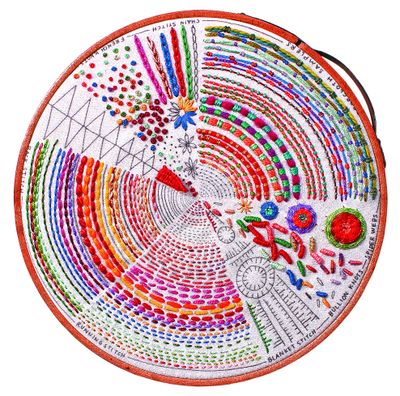Modern embroidery makes room for personality

Hand embroidery is the latest comeback kid among traditional handiwork, but what crafters are doing with needle and thread transcends the alphabet and “Home Sweet Home” samplers of yesteryear.
They’re using innovative designs and materials to take embroidery to artistic realms. Scroll through websites like Pinterest or Etsy and you’ll find human portraits drawn in thread, colorfully embroidered crazy quilts, and new uses for simple stitches like the running stitch or French knot.
“Yes, we’re seeing an embroidery resurgence,” says Linda Augsburg, executive editor at American Patchwork & Quilting magazine. She contrasts today’s innovations with the counted cross-stitch patterns popular in the 1980s, which “were precise and required following a chart.”
Today’s embroidery can be edgier or sillier – more individualistic. Some of it is “tattoo-ish,” incorporating flames and skulls, because embroidery has become deeply personal, Augsburg says, citing Jenny Hart as a leader in avant-garde embroidery.
There’s a larger trend in home decor and clothing toward greater personalization, Augsburg notes. A handmade pillow today is more likely to have a sarcastic comment embroidered on it than “Home Sweet Home” and, in a wink to the past, aprons may be embroidered with flowers, but they have faces.
It’s “whimsical and fun and silly, and I think we all want a little fun in our lives,” says Augsburg, from her Des Moines, Iowa, office.
This rule-bending pleases Rebecca Ringquist, author of the forthcoming “Rebecca Ringquist’s Embroidery Workshops” (STC Craft/A Melanie Falick Book). She encourages experimentation in the classes she teaches online at Creativebug and at workshops throughout the country.
“While an embroidery instructor in the 1950s might have insisted that your cloth be knot-free, I encourage you to do what it takes to get going, and to think of knots as an opportunity to add texture to even the front side of your fabric,” Ringquist says in her book.
She sees embroidery as akin to painting; stitches add layers of color and texture.
“Embroidery is very forgiving. If you don’t like it, you can pull stitches out or embroider over it,” says Ringquist, of Brooklyn, New York. “It’ll probably become thicker and more beautiful as you add more and more things.”
Embroidery is an accessible and affordable hobby, Augsburg says: Find needles, embroidery floss and hoops – a helpful (though not necessary) accessory that help keep fabric taut while you work on it – at any large crafts or small specialty store, and pay only a few dollars for initial supplies.
Ringquist recommends starting with the ubiquitous DMC 6-strand cotton floss, which comes in hundreds of colorfast colors and doesn’t tangle as easily as some threads.
Learn a few, simple stitches from a book, class or YouTube tutorial and get stitching on whatever you have – a pillowcase, a shirt, a skirt.
The March 2015 issue of Martha Stewart Living magazine shows how to make five classic embroidery stitches, and recommends a fast and easy project: Embroider onto pretty, printed fabric. It suggests turning the handiwork into pillows, sachets and hand towels.
“Everyone has fabric in their house. Everyone. Because everyone has clothing,” says Ringquist, who learned to embroider on her jeans, bathrobe, bed sheets and more. “It’s pretty low-risk. You haven’t spent any money and you’ve probably done some good for your nervous system in the process.”
Natalie Chanin, founder of Alabama Chanin, a clothing and accessories company, adds embroidery to the garments in her hand-made collection – as embellishments and in reverse applique.
“It is not new but I definitely see some very contemporary uses (of embroidery) happening on the runway now,” says Chanin. “As fashion becomes faster and faster, this kind of handiwork can really set something apart and give it a different life.”
To start, Chanin suggests working “around the neckline of a top. It’s one of the first parts you see.”
Chanin, who has authored three books in her “Alabama Studio” series, teaches hand-stitching techniques online at Craftsy and Creativebug and at her Florence, Alabama, studio.
The February 2015 issue of Better Homes and Gardens magazine shows a few of her embroidery gift ideas, from embellished cards to tea towels. The magazine has a book, “Better Homes and Gardens Embroidery” (Meredith Corp.), available in April.
Besides being attractive, embroidery’s personal touch can imbue handiwork with deeper meaning.
“If I’m making (a garment) for my daughter or my son or a friend, it’s also about this act of love that I want to give to them,” says Chanin.